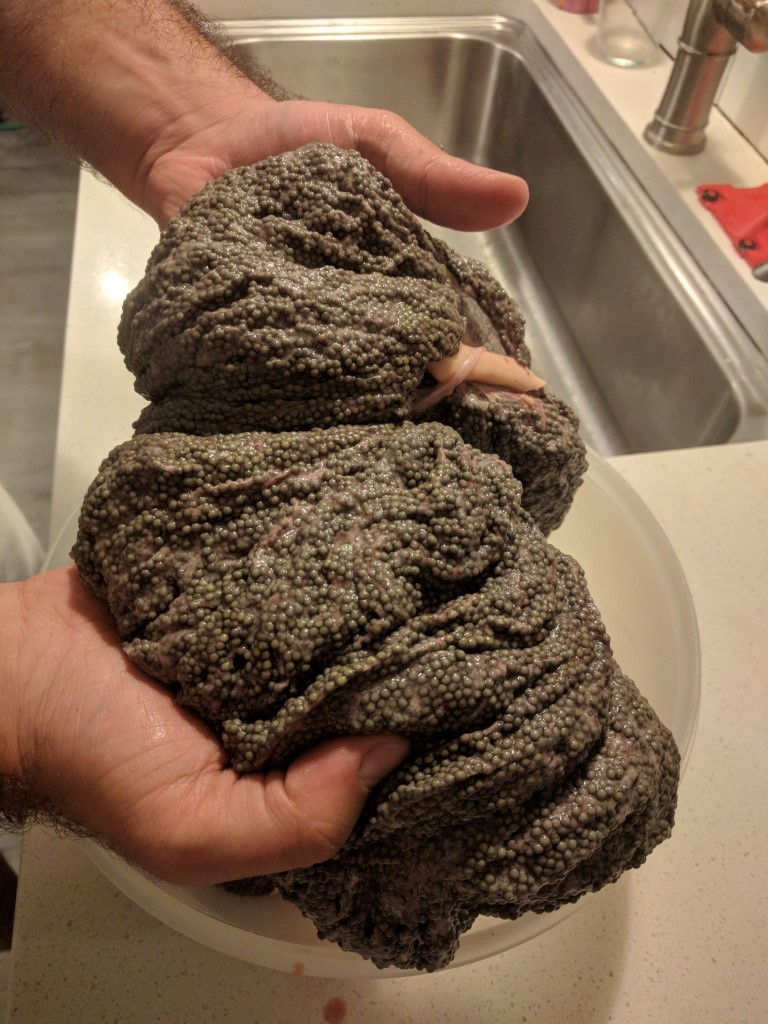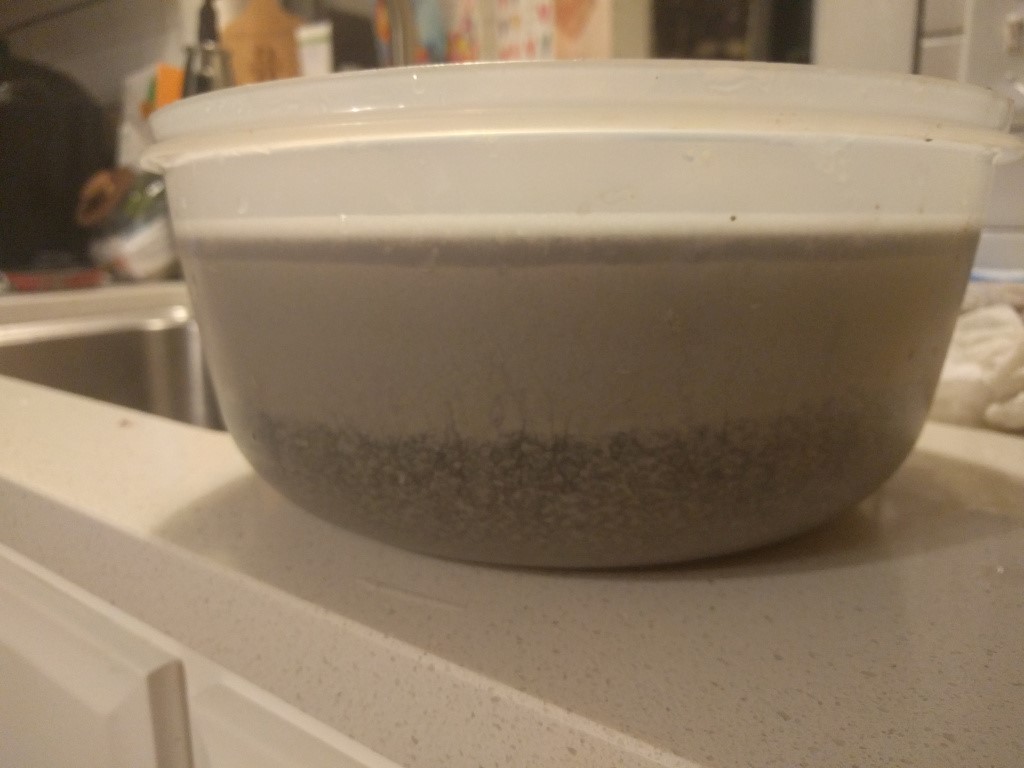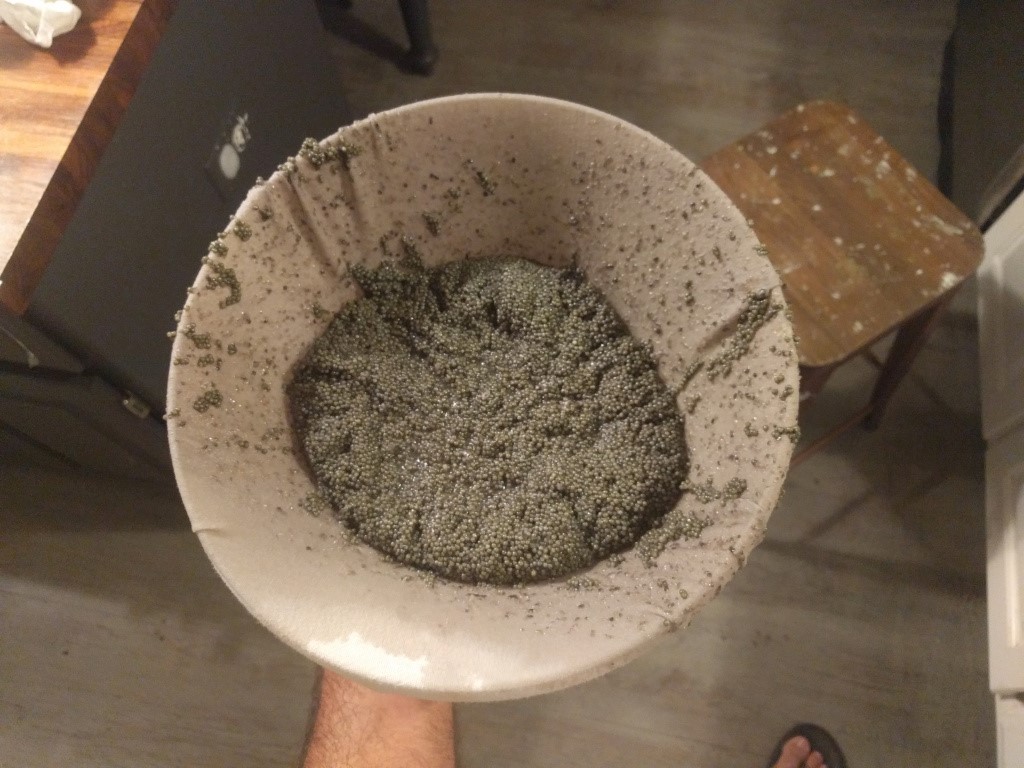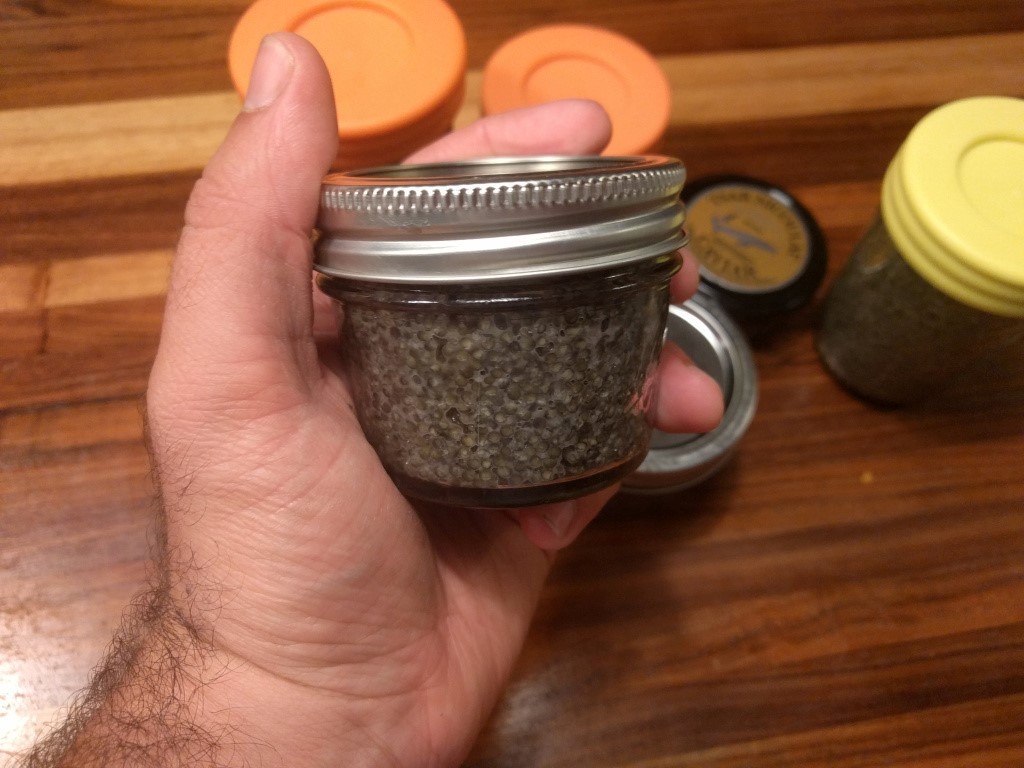DIY Paddlefish Caviar


by Gilbert Randolph
The river was low, silty banks glistening in the sun and I’d spent a few hours already trying to catch a paddlefish. I was casting into a long flat, thinking about the yellow morels I’d stuffed into my backpack, and how it seemed I might not get a fish that year. In the middle of my backswing, mind drifting away from the moment, my motion was suddenly stopped. I had one.
I planted the rod on my hip and settled in for the fight, careful not to let it pull me too close to the steeper parts of the bank. When it leapt out of the opaque, muddy water I couldn’t help but laugh. I yelled to my friend Stewart, who was a hundred yards down the bank, that I had one and went back to coaxing the fish away from snags.
Stewart slid down the bank, a log about the size of a fence post the only thing arresting his momentum. By now the fish was exhausted and I drug it towards where Stewart clung until he reached out and snatched it by the nose. It started to thrash, so I put my reel in free spoon, stuck it in the bank, and inched down to him. With one hand stuck as deep in the mud as it would go, I put my arm in the fish’s mouth and grabbed it around the gills. Then, step by step, I crawled back up the bank, hoping the fish was too tired to flop around and send me tumbling backwards into the water.
Once I had it on flat ground, there was the business of getting it back, a good mile hike through the woods. I heaved it on my shoulders and grabbed its rostrum in my left hand, its tail in my right. To get back to my car, I had to cross an old railroad bridge. As much as I told myself to not look down, I couldn’t help but crane my neck to watch the water rushing underneath me. As much as I told myself that the gap between the slats was too small for me to fall through, I help but imagine dropping into the water below, still clinging to my paddlefish. It was only after I’d started processing the fish that I realized it was full of roe, fish eggs.
So, off the cuff, I decided it was the time to learn to make caviar, and learn I did. WARNING: Before making caviar, make sure the water you harvest from is clean and know local regulations. In Missouri, it’s illegal to transport caviar or attempt to sell it. I highly discourage any attempt to sell paddlefish roe or caviar, as they are threatened in parts of the US and their population needs to be protected. Please only make for your personal consumption.
CAVIAR 101
In its most basic form, caviar is only two things: fish eggs and salt. When making caviar, you really don’t need fancy equipment, fancy knowledge, or fancy anything…except maybe fancy sensibilities. Truth be told, caviar is about as hillbilly as you can get. It’s hilarious that it’s become a universal symbol of wealth.
To make caviar you’ll need the following kitchen items: A mesh screen (I used a tennis racquet…seriously), a couple of large bowls, a sieve (cheesecloth or an old t-shirt can work in a pinch), and a kitchen scale. Oh, you might also need an unfavorable outlook on the proletariat.

This is a roe sack, only half of what I harvested from this fish.
You will also need: Roe (fish eggs), sea salt, glass jars to store your precious caviar.
The process: The simplified process is this: separating the eggs from the egg sack, rinsing the eggs in salty water, draining, salting the eggs, mixing, draining, and packing. That’s it. Now, let’s talk the details. Special thanks to Tulsa World, who posted the method that I use. You can read their article here.
HOMEMADE PADDLEFISH CAVIAR
Ingredients: coarse sea salt, roe
Removing the Roe from the Fish:
- To remove the roe from a paddlefish, you need to carefully cut open the belly from the anus to the chin of the fish. Be careful not to cut too deeply, as you might damage the roe sacks.
- Once you’ve made an incision, you’ll see the stomach, liver, and other organs. If a paddlefish has roe, it will be large, gray sacks, filled with tiny, gray balls. At this point, you can gently pull most of it out, though you may need to cut the top of the roe sack off where it is attached to the inside of the fish to avoid damaging the eggs.
- immediately refrigerate or ice the egg sacks.
Making the Caviar:
- Take a bowl and place your mesh screen (or racquet of choice) on top. Now, rub the eggs gently, but firmly across the mesh. Doing so will separate the eggs from the sack so they can be processed. You will lose some of the eggs in this process, but don’t worry. They’ll be plenty left.

I poured the eggs directly into the saltwater.
2. Once all the roe has been separated from the roe sacks, you will need to rinse them with slightly salty water. You can put the eggs in a fine sieve and pour the water through or dump the eggs directly in the saltwater and then drain.
3. Now that your eggs are well rinsed, place them in a clean bowl and measure their weight. Make sure you tare off the weight of the bowl!

Don’t skimp on the quality of the salt.
4. Now, add 3-3.5% of the egg weight in salt to the bowl. So, if you have 100 grams of eggs, you’ll want to add 3 to 3.5 grams of salt.
5. Gently mix the eggs by hand for ten minutes.
6. After mixing, let them sit for 30 minutes. The eggs are going to increase in firmness because of the salt, as well as expel some of their water. You can place the eggs on a draining surface if you like.
7. Pour the eggs into a sieve to drain off the excess moisture.

8. Pack into jars and store in your fridge for up to four to six weeks. OR you can freeze the caviar. Some say not to freeze them, as it will make the texture less firm, however, I had TWO POUNDS of processed caviar when I was done and there was no way I was going to eat it all in a couple of weeks. As long as your caviar is stored in airtight containers, it will be fine and will retain the flavor and some of the original texture.

What should it taste like? My caviar came out tasting briny, earthy, and creamy. It has a little stronger taste than sturgeon caviar, but it’s milder than salmon or whitefish roe. It shouldn’t taste bitter or have a strong smell. Let your taste buds speak to you. If you like caviar, you’ll love paddlefish caviar. If you don’t like caviar…well, let your friends eat it.
For more great wild food recipes, check out www.thenerdventure.wordpress.com and follow Gilbert on Instagram @gilbertwriting
